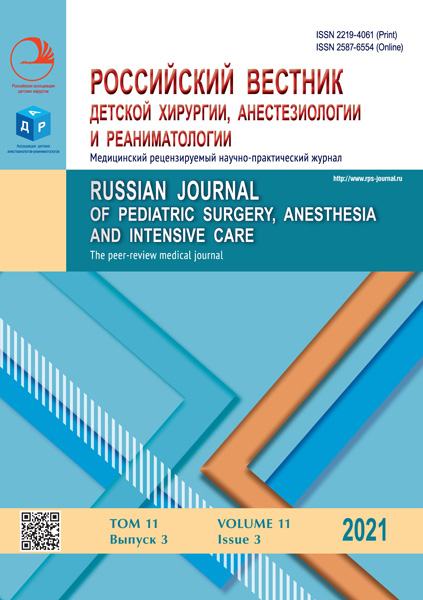Treatment of children with incomplete duodenal membrane
- 作者: Nafikova R.A.1,2, Gumerov A.A.3, Galimov I.I.3, Neudachin A.E.4
-
隶属关系:
- Bashkir State Medical University
- Republican Children’s Hospital
- Bashkir state medical university
- Republican children's hospital
- 期: 卷 11, 编号 3 (2021)
- 页面: 359-366
- 栏目: Original Study Articles
- URL: https://bakhtiniada.ru/2219-4061/article/view/123554
- DOI: https://doi.org/10.17816/psaic977
- ID: 123554
如何引用文章
全文:
详细
BACKGRAUND: An incomplete or perforated duodenal membrane is a rare developmental pathology of the gastrointestinal tract.
AIM: This study aimed to analyze the diagnostic and treatment results of children with an incomplete duodenal membrane in the Republican Children’s Clinical Hospital in Ufa.
MATERIALS AND METHODS: This study retrospectively analyzed case histories of 34 children who underwent surgery for incomplete duodenal membrane from 2005 to 2020. Features of the life history of the children, clinical picture of the disease, presence of concomitant developmental anomalies, laboratory and instrumental examination data, surgical correction methods, and postoperative period were analyzed. All children underwent ultrasound examination of the abdominal organs and contrast-enhanced radiography of the upper gastrointestinal tract with barium sulfate. Esophagogastroduodenoscopy was performed in 17 cases.
RESULTS: Antenatally, the diagnosis was made in 21 cases. Patients’ age at the time of hospitalization was 9.7 ± 2.7 days. Children were presented with symptoms such as persistent regurgitation or vomiting of curdled milk, which was sometimes mixed with bile (22 cases). Bloating in the epigastric region, retraction of the lower abdomen, and low weight gain after birth were found in nine children, and in five children, no weight changes were observed. Moreover, 13 (38.2%) children had concomitant developmental anomalies; 4 (11.7%) children had Down syndrome. Surgical treatment of 10 children was performed laparoscopically. Of the 24 children, three received laparotomic access, including conversion. The procedures included duodenotomy, partial excision of the membrane, and suturing of the duodenum. Enteral feeding was started 4.9 ± 0.6 days after surgery. The average duration of hospitalization was 27 ± 1.4 days.
CONCLUSION: Vomiting or frequent regurgitation in infants and low-weight gain should alert pediatricians and pediatric surgeons. Malformation of the duodenal membrane in combination with other malformations necessitates a comprehensive examination. Laparoscopic excision of the duodenal membrane is the preferred treatment.
作者简介
Radmila Nafikova
Bashkir State Medical University; Republican Children’s Hospital
编辑信件的主要联系方式.
Email: nafikova.radmila@mail.ru
ORCID iD: 0000-0003-2850-9178
SPIN 代码: 8349-4929
postgraduate student
俄罗斯联邦, 3 Lenina str., Ufa, 450008; UfaAitbai Gumerov
Bashkir state medical university
Email: pedsurg@bk.ru
ORCID iD: 0000-0001-6183-8286
Dr. Sci. (Med.), professor
俄罗斯联邦, 3 Lenina str., Ufa, 450008Ildar Galimov
Bashkir state medical university
Email: gildar777@mail.ru
ORCID iD: 0000-0002-3970-9338
Сand. Sci. (Med.), associate professor
俄罗斯联邦, 3 Lenina str., Ufa, 450008Artem Neudachin
Republican children's hospital
Email: nartem73@mail.ru
ORCID iD: 0000-0002-7448-5835
pediatric surgeon
俄罗斯联邦, 3 Lenina str., Ufa, 450008参考
- Kozlov YuA, Podkamnev VV, Novozhilova VA. Neprokhodimost’ zheludochno-kishechnogo trakta u detei: natsional’noe rukovodstvo. Moscow: GEOTAR-Media, 2017. 189–224 p. (In Russ.)
- Rostovtsev NM, Boboshko PG, Bazalyi VN, et al. Results of neonatal duodenal obstruction treatment. Pediatric bulletin of the South Ural. 2016;(2):63–66. (In Russ.)
- Ladd AP, Madura JA. Congenital duodenal anomalies in the adult. Arch Surg. 2001;136:576–584. doi: 10.1001/archsurg.136.5.576
- Castro PT, Matos AP, Werner H, Araujo E. Congenital Duodenal Stenosis: Prenatal Evaluation by Three-dimensional Ultrasound HD live Silhouette Mode, Magnetic Resonance Imaging, and Postnatal Outcomes. Case Reports. J Med Ultrasound. 2019;27(3):151–152. doi: 10.4103/JMU.JMU_14_19
- Zimmer V, Bergheim Ch. Late-presenting duodenal web. Clin Gastroenterol Hepatol. 2020;18(1):35–44. doi: 10.1016/j.cgh.2018.08.072
- Maldonado G, Paredes C, Cedeño H, et al. Duodenal membranes: a late diagnosis evidenced by foreign bodies. Case Reports. Oxf Med Case Reports. 2017;12:253–254. doi: 10.1093/omcr/omx071
- Tsap NA, Rokina LV, Gaidysheva EV, et al. Membranoznaya neprokhodimost’ dvenadtsatiperstnoi kishki. Russian Journal of Pediatric Surgery. 2019;23(10):66–71. (In Russ.)
- Mirza B, Ijaz L, Saleem M, Sheikh A. Multiple associated anomalies in a single patient of duodenal atresia: a case report. Cases J. 2008;6:215. doi: 10.1186/1757-1626-1-215
- Lee SS, Hwang ST, Jang NG, et al. A case of congenital duodenal web causing duodenal stenosis in a Down syndrome child: endoscopic resection with an insulated-tip knife. Gut Liver. 2021;15(4):105–109. doi: 10.5009/gnl.2011.5.1.105
- Mahendra K, Reyaz A, Sujeet P. Delayed presentation of a congenital duodenal web managed successfully with incision of web. BMJ Case Report. 2020;22:e237307. doi: 10.1136/bcr-2020-237307
- Rattan KN, Singh J, Dalal P. Delayed presentation of congenital intrinsic duodenal obstruction in children with non-bilious vomiting: a diagnostic dilemma. J Ped Neonates. 2018;7:285–294. doi: 10.7363/070218
- Bethell GS, Long A-M, Knight M, Hall NJ. Congenital duodenal obstruction in the UK: a population-based study. Arch Dis Child Fetal Neonatal Ed. 2020;105(2):178–185. doi: 10.1136/archdischild-2019-317085
- Chung PH, Wong CW, Ip DK, et al. Is laparoscopic surgery better than open surgery for the repair of congenital duodenal obstruction? A review of the current evidences. J Pediatr Surg. 2017;52(3):498–505. doi: 10.1016/j.jpedsurg.2016.08.010
补充文件






